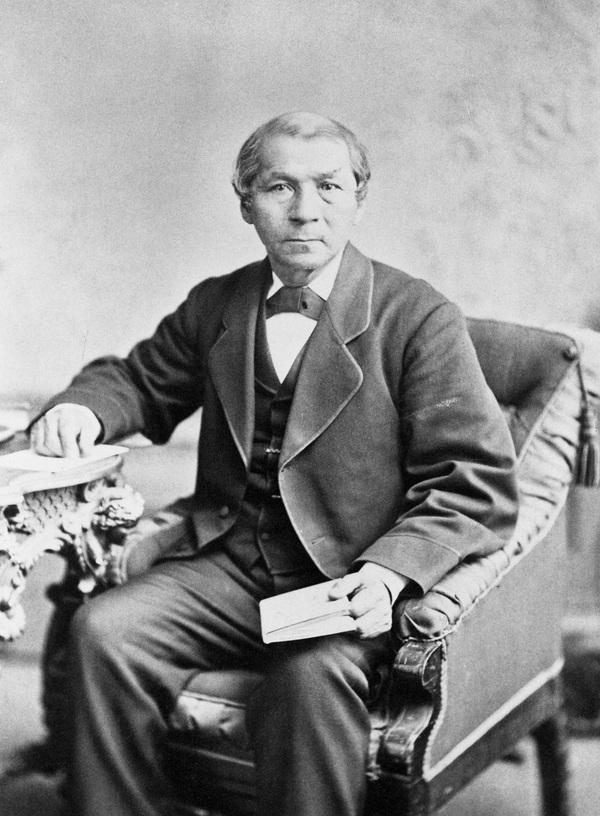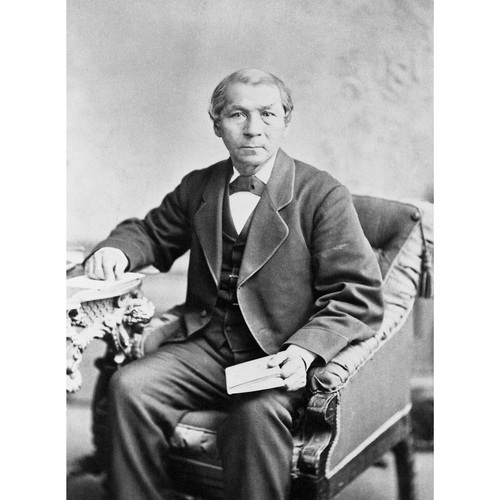
Source: Link
STEINHAUER, HENRY BIRD (probably also known as Sowengisik, and may originally have been baptized as George Kachenooting), Methodist missionary, school teacher, and translator; b. probably c. 1818 in Upper Canada near the present Rama Indian Reserve, eldest son of Bigwind and Mary Kachenooting; m. 5 Aug. 1846 Mamenawatum (Seeseeb, Jessie Joyful) at Norway House (Man.), and they had five daughters and five sons (a great-grandson, Ralph Garvin Steinhauer*, was lieutenant governor of Alberta from 1974 to 1979); d. 29 Dec. 1884 at Whitefish Lake (Alta).
The Ojibwa who became Henry Bird Steinhauer in 1828 was probably originally named Sowengisik. He took the new name after Methodist missionary William Case* found an American benefactor who agreed to provide for the education of an Indian youth if that youth adopted his name. It is possible that Steinhauer was also the person baptized as George Kachenooting by Case earlier in 1828, on 17 June, at Holland Landing, Upper Canada. Steinhauer attended the Grape Island school at the south end of Lake Couchiching from 1829 to 1832, and the Cazenovia Seminary in Cazenovia, N.Y., from 1832 to 1835. He was appointed by the Wesleyan Methodist Church to teach at the Credit River mission on Lake Ontario in 1835, and the following year Egerton Ryerson enrolled him at the Upper Canada Academy in Cobourg. His studies at the academy were interrupted for the year 1837–38 by an appointment to teach at the Alderville mission school in Northumberland County, Upper Canada, to which he returned after he graduated in 1839, at the head of his class.
In 1840 Steinhauer was dispatched to Lac La Pluie (Rainy Lake, Ont.) where he assisted the Reverend William Mason as translator, interpreter, and teacher. Two years later, at the request of missionary James Evans*, he was sent to Rossville mission near Norway House. Evans felt that Steinhauer would readily master Cree because he spoke Ojibwa, which belongs to the same language group, and would thus be able to assist him in translating the Bible and hymns into his system of Cree syllabics. Steinhauer was the chief translator at Norway House by 1846. In 1851 he was asked to establish a Methodist mission at Oxford House (Man.), 200 miles northeast of Norway House, and he built the mission 20 miles from the Hudson’s Bay Company fort. In the fall of 1854 Steinhauer, who was then the only Methodist missionary west of Norway House, accompanied John Ryerson* to England to publicize the western missionary work, returning the following spring.
Steinhauer was ordained at the conference of the Wesleyan Methodist Church in Canada in London, Canada West, in June 1855, and on the 8th of that month received news of his posting to Lac La Biche (Alta). He was not overly pleased with the posting and thought he might wish to return to the east for his children’s education. He travelled west with Thomas Woolsey*, who was posted to Pigeon Lake (Alta). Although they were at the time the only Methodist missionaries in the northwest, they found that they were “surrounded by Romanists” and felt that they were “very closely watched by their two priests.” Lac La Biche was originally selected for Steinhauer “on account of its being out of reach of the enemy, the murderous Blackfoot,” but because he considered the location so removed from HBC posts, he did not encourage the development of a settled mission community there. He preferred instead to travel extensively among the Cree to carry out missionary activities.
The intense rivalry with the Roman Catholic missionaries at Lac La Biche, and the post’s isolation from the fur-bearing animals and the buffalo herds, led Steinhauer, during the early summer of 1858, to move his mission south to Whitefish Lake where there was a band of Cree. The location was ideal, with land suitable for agriculture and a lake abounding with fish. During the winter of 1859–60, when smallpox swept the prairies, Steinhauer temporarily moved the band as a quarantine measure, and no lives were lost. He further ensured the well-being of his mission by discouraging traders from establishing trading-posts in the area in order to reduce the influx of alcohol. In 1864 Steinhauer opened the first Protestant church in the region, at Whitefish Lake. Later that year his eldest daughter, Abigail, was married in the church to John Chantler McDougall*, whose father, the Reverend George Millward McDougall*, performed the ceremony. With George McDougall and Peter Erasmus*, Steinhauer visited the Mountain Stonies that fall in an attempt to expand missionary work among them. Abigail was one of 16 people who died at Whitefish Lake during the smallpox epidemic of 1870. Such epidemics as well as poverty, hunger, and alcohol were continual problems surrounding mission work.
Steinhauer was appointed to Woodville, on Pigeon Lake, southwest of Edmonton, for the 1873–74 season. The Whitefish Lake mission was to be tended in his absence by Benjamin Sinclair, a local leader, but when he returned Steinhauer found it a shambles. Many families had moved away, fields were untended, and church attendance was down.
In an unusually critical letter to the Missionary Society of the Wesleyan Methodist Church in Canada, published in 1875, Steinhauer wrote, “A foreigner either as a missionary or otherwise, will never take so well with the natives of this country . . . there is always a distrust on the part of a native to the foreigner, from the fact that the native has been so long down-trodden by the white man.” He referred to the immigration of whites into the west as a “blighting and benighting” influence and also criticized the missionary society for not heeding his pleas for essential materials. This letter represents a turning-point in Steinhauer’s appraisal of his role as a missionary to the Cree. Although he never ceased to maintain his religious convictions, he did become less of a traditional missionary by, in effect, severing his obligations to the missionary society and asserting his Indian identity.
Shortly after his return from a conference in Brandon, Man., in 1884, an influenza epidemic swept the North-West Territories and Steinhauer fell seriously ill. He died on 29 December.
UCA, Biog. files, H. B. Steinhauer. Methodist Church of Canada, Missionary Soc., Annual report (Toronto), 1875–77. Wesleyan Methodist Church in Canada, Missionary Soc., Annual report (Toronto), 1856; 1872–74. Christian Guardian, 1833; 1854–55; 29 April 1864. Cornish, Cyclopædia of Methodism. J. [C.] McDougall, Parsons on the plains, ed. Thomas Bredin (Don Mills, Ont., 1971). John Maclean, Henry B. Steinhauer, his work among the Cree Indians of the western plains of Canada (Toronto, n.d.); James Evans, inventor of the syllabic system of the Cree language (Toronto, [1890]); Vanguards of Canada (Toronto, 1918). J. H. Riddell, Methodism in the middle west (Toronto, [1946]). [A. D.] Stephenson, One hundred years of Canadian Methodist missions, 1824–1924 (Toronto, 1925). Gerald Hutchinson, “Early Wesleyan missions,” Alberta Hist. Rev. (Edmonton), 6 (1958), no.4: 1–6. M. E. Jordon, “Henry Bird Steinhauer and the Whitefish Lake mission,” Alberta Hist. Rev., 3 (1955), no.4: 11–12. Margaret Stewart, “Indian receives D.D. degree,” Onward: a Paper for Young Canadians (Toronto), 10 Oct. 1937. J. A. Youmans, “Along the line; Manitoba conference; the late H. B. Steinhauer,” Missionary Outlook: a Monthly Advocate, Record, and Rev. (Toronto), 5 (1885), no.2: 25, 28.
Cite This Article
Krystyna Z. Sieciechowicz, “STEINHAUER, HENRY BIRD (Sowengisik, George Kachenooting),” in Dictionary of Canadian Biography, vol. 11, University of Toronto/Université Laval, 2003–, accessed January 18, 2026, https://www.biographi.ca/en/bio/steinhauer_henry_bird_11E.html.
The citation above shows the format for footnotes and endnotes according to the Chicago manual of style (16th edition). Information to be used in other citation formats:
| Permalink: | https://www.biographi.ca/en/bio/steinhauer_henry_bird_11E.html |
| Author of Article: | Krystyna Z. Sieciechowicz |
| Title of Article: | STEINHAUER, HENRY BIRD (Sowengisik, George Kachenooting) |
| Publication Name: | Dictionary of Canadian Biography, vol. 11 |
| Publisher: | University of Toronto/Université Laval |
| Year of publication: | 1982 |
| Year of revision: | 1982 |
| Access Date: | January 18, 2026 |



